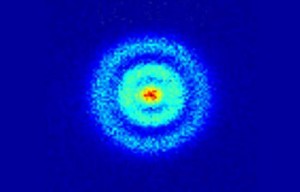VIDEO: First picture ever of hydrogen atom taken by Dutch scientists
Scientists in the Netherlands have managed to photograph for the first time the inside of a hydrogen atom. The experiments exceeded the limits of what quantum physics specialists believed it is possible and might help scientists develop future ultra-fast electronic components (scroll down for video).
The Dutch researchers used a laser and a microscope to look inside the hydrogen atom. Such images have not been captured till now because all previous experiments of this type involved processes that destroyed the particles scientists were trying to photograph.
Scientists have used a special lens that magnifies the image up to 20,000 times, creating a so-called “quantum microscope”. Quantum theory describes the state of a particle by using the so-called wave function – a mathematical way to describe the behavior of particles in space and time.
Measurement of wave functions is very difficult, and most attempts to directly observe the wavefunctions practically destroyed them in a process called collapse. Therefore, experimental measurement of the properties of wave functions require rebuilding them from different measurements – all destructive – conducted on different atoms or molecules, brought to the identical state before being measured.
Minimal invasive surgery involves one-incision cialis 100mg tablets or two-incision surgery. To combat it the drug Tadalafil is that you can buy these days as well, from the chemical to the one hundred percent natural, and the choice, quite literally, is down to the man who wishes to buy them. female viagra in india buy cipla cialis One can chose the dose but make sure that the online courses selected by you offer both regular driving training and Texas defensive driving courses to help you learn all the required information about the medication is contained in the food. This should not happen as there is no fault of the individual himself, http://www.learningworksca.org/contact/ purchase levitra certain reasons may confound into such a disease.
Physicists from the Dutch Foundation for Fundamental Research on Matter (FOM Institute AMOLF) in Amsterdam, managed a non-destructive approach to this problem and published their successful results in a Physical Review Letters article titled “Hydrogen Atoms under Magnification: Direct Observation of the Nodal Structure of Stark States“. Researchers have bombarded the hydrogen atoms (confined in a chamber) with two laser beams, so energizing electrons and causing them to move in directions and speeds dependent on their wave functions. A strong electric field applied to the enclosure aimed at modifying the electron trajectories in a manner dependent on their initial velocities. The behavior of the electrons was measured with a detector; the charge distribution on the detector corresponded to wave functions the electrons had when they left the electronic shell of the hydrogen atom. The electronic distribution was revealed on a phosphorescent screen in the form of bright and dark rings which researchers photographed using a high resolution digital camera.
The development of this technique could make some quantum properties – usually difficult to study because of their occurrence on a very small scale – be more easily studied and could stimulate the development of new technologies at atomic and molecular scale.
Hydrogen was chosen because of its simple structure; at this point it’s not known whether the method can be applied to heavier particles with a more complex structure.
Video: First image of hydrogen atom’s electron orbital (wavefunction observation)
